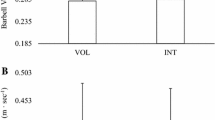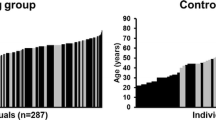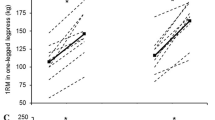Abstract
Maximum strength training induces various improvements in the rate of force development (RFD) on a group level, but no study has investigated inter-individual adaptations in RFD. Fourteen men (28 ± 6 years old) performed the same 10-week maximum strength and then a 10-week power training program. Maximal force and RFD were recorded during maximal isometric leg extension voluntary contractions repeatedly before every 7th training session (2 sessions/week). After the intervention, subjects were retrospectively divided into three groups based on their RFD improvements: (1) improved only during the maximum strength period (MS-responders, + 100 ± 35%), (2) improved only during the power period (P-responders, + 53 ± 27%) or (3) no improvement at all (non-responders, + 3 ± 9%). All groups increased dynamic 1RM equally, but baseline 1RM was greater (p < 0.05) in responder vs non-responder groups. MS-responders had higher electrical stimulation-induced torque at baseline and they improved (+ 35 ± 28%) power production at 50% 1RM load more than P- (− 7 ± 20%, p = 0.052) and non-responders (+ 3 ± 6%, p = 0.066) during the maximum strength training period. MS-responders increased vastus lateralis cross-sectional area (+ 12 ± 9%, p < 0.01) as did P-responders (+ 10 ± 7%, p = 0.07), whereas non-responders were unchanged. Free androgen index (FAI) in responders was higher (+ 34%, p < 0.05) compared to non-responders at baseline. The maximum strength period decreased testosterone (− 17 ± 12; 17 ± 22%), FAI ratio (− 12 ± 14; − 21 ± 23%) and testosterone/cortisol ratio (− 17 ± 25; − 31 ± 20%) in MS and P-responders, respectively. During the P-period hormonal levels plateaued. To conclude, periodized strength training induced different inter-individual physiological responses, and thus RFD development may vary between individuals. Therefore, RFD seems to be a useful tool for planning and monitoring strength training programs for individual neuromuscular performance needs.




Similar content being viewed by others
References
Ahtiainen JP, Häkkinen K (2009) Strength athletes are capable to produce greater muscle activation and neural fatigue during high-intensity resistance exercise than nonathletes. J Strength Cond Res 23(4):1129–1134
Ahtiainen JP, Hoffren M, Hulmi JJ, Pietikäinen M, Mero AA, Avela J, Häkkinen K (2010) Panoramic ultrasonography is a valid method to measure changes in skeletal muscle cross-sectional area. Eur J Appl Physiol 108(2):273–279
Ahtiainen JP, Walker S, Peltonen H, Holviala J, Sillanpää E, Karavirta L, Sallinen J, Mikkola J, Valkeinen H, Mero A, Hulmi JJ (2016) Heterogeneity in resistance training-induced muscle strength and mass responses in men and women of different ages. AGE 38(1):1–3
Andersen JL, Aagaard P (2010) Effects of strength training on muscle fiber types and size; consequences for athletes training for high-intensity sport. Scand J Med Sci Sports 20(Suppl. 2):32–38
Andersen LL, Andersen JL, Zebis MK, Aagaard P (2010) Early and late rate of force development: differential adaptive responses to resistance training? Scand J Med Sci Sports 20:e162–e169
Angelozzi M, Madama M, Corsica C, Calvisi V, Properzi G, McCaw ST, Cacchio A (2012) Rate of force development as an adjunctive outcome measure for return-to-sport decisions after anterior cruciate ligament reconstruction. J Orthop Sports Phys Ther 42:772–780
Baker D (2001) Comparison of upper-body strength and power between professional and college-aged rugby league players. J Strength Cond Res 15(1):30–35
Bellemare F, Bigland-Ritchie B (1984) Assessment of human diaphragm strength and activation using phrenic nerve stimulation. Respir Physiol 58:263–277
Busso T, Häkkinen K, Pakarinen A, Carasso C, Lacour JR, Komi PV, Kauhanen H (1990) A systems model of training responses and its relationship to hormonal responses in elite weight-lifters. Eur J Appl Physiol Occup Physiol 61(1–2):48–54
Churchward-Venne TA, Tieland M, Verdijk LB, Leenders M, Dirks ML, de Groot LC, van Loon LJ (2015) There are no non-responders to resistance-type exercise training in older men and women. J Am Med Dir Assoc 16(5):400–411
Cormie P, McGuigan MR, Newton RU (2010) Influence of strength on magnitude and mechanisms of adaptation to power training. Med Sci Sports Exerc 42(8):1566–1581
Cormie P, McGuigan MR, Newton RU (2011) Developing maximal neuromuscular power: part 2—training considerations for improving maximal power production. Sports Med 41(2):125–146
Crameri RM, Aagaard P, Qvortrup K, Langberg H, Olesen J, Kjaer M (2007) Myofibre damage in human skeletal muscle: effects of electrical stimulation versus voluntary contraction. J Physiol 583:365–380
Erskine RM, Jones DA, Williams AG, Stewart CE, Degens H (2010) Inter-individual variability in the adaptation of human muscle specific tension to progressive resistance training. Eur J Appl Physiol 110:1117
Foster C, Rodriguez-Marroyo JA, de Koning JJ (2017) Monitoring training loads: the past, the present, and the future. Int J Sports Perform 12(S2):2–8
Fry AC, Kraemer WJ, Stone MH, Warren BJ, Fleck SJ, Kearney JT, Gordon SE (1994) Endocrine responses to overreaching before and after 1 year of weightlifting. Can J Appl Physiol 19(4):400–410
Garnett R, Stephens JA (1981) Changes in the recruitment threshold of motor units produced by cutaneous stimulation in man. J Physiol 311:463–473
Hackney AC (2006) Stress and the neuroendocrine system: the role of exercise as a stressor and modifier of stress. Expert Rev Endocrinol Metab 1(6):783–792
Hackney AC, Lane AR (2015) Exercise and the regulation of endocrine hormones. Prog Mol Biol Transl Sci 135:293–311
Haff GG, Jackson JR, Kawamori N, Carlock JM, Hartman MJ, Kilgore JL, Morris RT, Ramsey MW, Sands WA, Stone MH (2008) Force-time curve characteristics and hormonal alterations during an eleven-week training period in elite women weightlifters. J Strength Cond Res 22(2):433–446
Häkkinen K, Myllylä E (1990) Acute effects of muscle fatigue and recovery on force production and relaxation in endurance, power and strength athletes. J Sports Med 30(1):5–12
Häkkinen K, Pakarinen A, Alén M, Komi PV (1985) Serum hormones during prolonged training of neuromuscular performance. Eur J Appl Physiol Occup Physiol 53(4):287–293
Hermens HJ, Freriks B, Disselhorst-Klug C, Rau G (2000) Development of recommendations for SEMG sensors and sensor placement procedures. J Electromyogr Kinesiol 10(5):361–374
Jenkins ND, Housh TJ, Traylor DA, Cochrane KC, Bergstrom HC, Lewis RW, Schmidt RJ, Johnson GO, Cramer JT (2014) The rate of torque development: a unique, non-invasive indicator of eccentric-induced muscle damage? Int J Sports Med 35:1190–1195
Kraemer WJ, Marchitelli L, Gordon SE, Harman E, Dziados JE, Mello R, Frykman P, McCurry D, Fleck SJ (1990) Hormonal and growth factor responses to heavy resistance exercise protocols. J Appl Physiol 69(4):1442–1450
Maffiuletti NA, Aagaard P, Blazevich AJ, Folland J, Tillin N, Duchateau J (2016) Rate of force development: physiological and methodological considerations. Eur J Appl Physiol 116(6):1091–1116
Meeusen R, Duclos M, Foster C, Fry A, Gleeson M, Nieman D, Raglin J, Rietjens G, Steinacker J, Urhausen A (2013) Prevention, diagnosis, and treatment of the overtraining syndrome: joint consensus statement of the European College of Sport Science and the American College of Sports Medicine. Med Sci Sports Exerc 45(1):186–205
Mujika I, Padilla S (2003) Scientific bases for precompetition tapering strategies. Med Sci Sports Exerc 35(7):1182–1187
Penailillo L, Blazevich A, Numazawa H, Nosaka K (2015) Rate of force development as a measure of muscle damage. Scand J Med Sci Sports 25:417–427
Ryushi T, Hakkinen K, Kauhanen H, Komi PV (1988) Muscle fiber characteristics, muscle cross-sectional area and force production in strength athletes, physically active males and females. Scand J Sports Sci 10(1):7–15
Stephens JA, Garnett R, Bulli NP (1978) Reversal of recruitment order of single motor units produced by cutaneous stimulation during voluntary muscle contraction in man. Nature 272:362–364
Vermeulen A, Verdonck L, Kaufman JM (1999) A critical evaluation of simple methods for the estimation of free testosterone in serum. J Clin Endocrinol Metab 84:3666–3672
Zatsiorsky VM, Kraemer WJ (2006) Science and practice of strength training. Hum Kinet
Author information
Authors and Affiliations
Corresponding author
Additional information
Communicated by William J. Kraemer.
Rights and permissions
About this article
Cite this article
Peltonen, H., Walker, S., Hackney, A.C. et al. Increased rate of force development during periodized maximum strength and power training is highly individual. Eur J Appl Physiol 118, 1033–1042 (2018). https://doi.org/10.1007/s00421-018-3836-9
Received:
Accepted:
Published:
Issue Date:
DOI: https://doi.org/10.1007/s00421-018-3836-9




